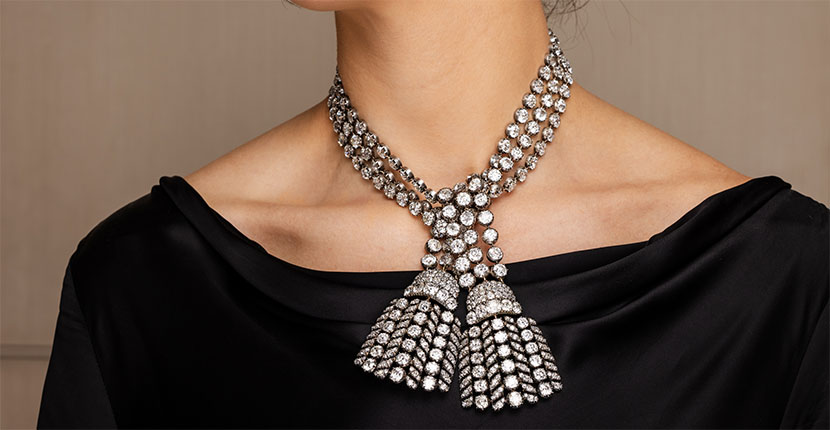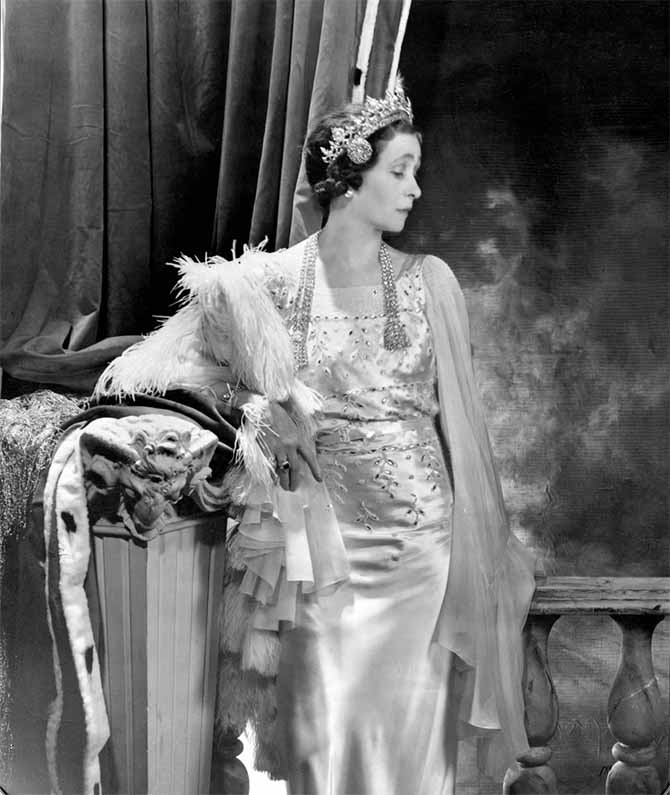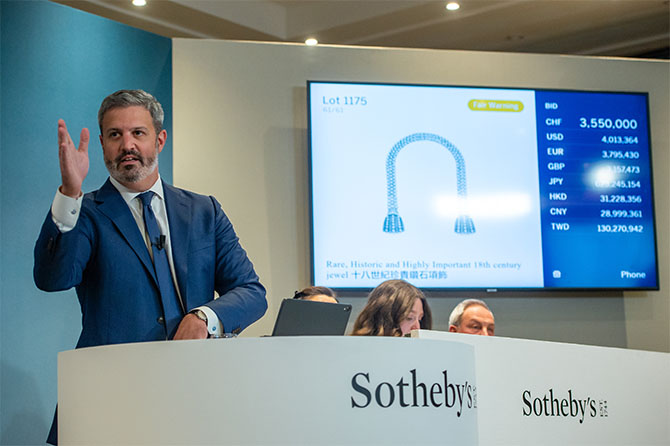
A model wearing the Important 18th century diamond jewel sold by Sotheby's with a possible link to Marie Antoinette's 'Affair of the Necklace.' Photo Sotheby's
Jewelry History
Historic Diamond Jewel Shatters Estimate at Sotheby’s
The piece has a possible link to Marie Antoinette’s ‘Affair of the Necklace’
November 14, 2024—Last night at Sotheby’s in Geneva, auctioneer Quig Bruning presided over the sale of the 18th century necklace with a possible link to Marie Antoinette’s ‘Affair of the Necklace.’ While there isn’t a shred of actual evidence to prove that the jewel was part of the one that the French people mistakenly linked to the queen and ultimately became a factor that hastened the French Revolution, there are some solid theories.
The date of the necklace coincides with the reign of Marie Antoinette. While it’s not the exact design, it looks like it could be a segment of the ‘Affair of the Necklace’ jewel. The tassels at the ends of the unique open piece and the triple row of diamonds are hauntingly similiar to the design by jewelers Bassenge et Böhmer.
There is also the sheer luxury of the jewel. The 500 diamonds, weighing over 300 carats, illustrate just how decadent the court of Versailles was at the time. And it reflects a level of wealth that only important royalty or aristocracy could afford.

All of these factors made it newsworthy, not to mention the fact that the jewel was later owned by the stylish Marquesses of Anglesey, an Anglo-Welsh family who sported the piece on key occasions.
For the coronation of King George VI in 1937, Marjorie Paget, Marchioness of Anglesey, tossed on the jewel with the Anglesey tiara. The look was captured in a photograph by Cecil Beaton. For the coronation of Queen Elizabeth in 1953, the Marchioness’s daughter-in-law put on the same jewels.

The seventh Marquess of Anglesey sold the piece around 1960. It resurfaced once in a bicentennial exhibition at the American Museum of Natural History in New York in 1976 before being acquired by the private Asian collection that sold it at Sotheby’s.
In the Geneva auction room, seven bidders battled it out for more than seven minutes. They drove the price well above the low estimate of $1,796,662 to the final price of $4,837,060. At the time of publication, the buyer has remained anonymous.

The appearance of the 18th-century necklace, possibly linked to Marie Antoinette’s “Affair of the Necklace,” lit up not only the elite who have the means to purchase such an extraordinary piece of jewelry, but also the imaginations of those of us who love to see and study it.
Jewelry like this necklace is tangible history and evidence of extraordinary technique. One fascinating fact about it is that the back is not closed like so many 18th century jewels, but open or à jour set to let the light shine through the stones. The tassels don’t move, but are flat so that they are stable against the body when worn.
When I had the opportunity to view the jewel with Frank Everett at Sotheby’s in New York, it felt like half the jewelry world dropped in at the same time. It reminded me that jewelry like this is also about a community of treasure seekers and dreamers.
Related Stories:
When and Why the French Sold the Crown Jewels
The Story of Louis Comfort Tiffany’s Medusa
Henry VIII’s Favorite Jewelry Designer
Get a gem in your mailbox SIGN UP FOR THE ADVENTURINE NEWSLETTER




